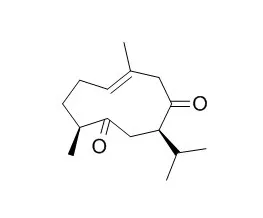| Description: |
Curdione has anti-inflammatory, cancer chemopreventive activities, significant anti-platelet aggregation and antithrombotic activities , the inhibitory mechanism of curdione on platelet aggregation may increase cAMP levels and subsequently inhibit intracellular Ca2+ mobilization. plays an important role in the CYP3A4 inhibitory activity of C. aromatica.
|
| Targets: |
Bcl-2/Bax | Caspase | P450 (e.g. CYP17) | COX | cAMP | Calcium Channel |
| In vitro: |
| Asian Pac J Cancer Prev. 2014;15(22):9997-10001. | | Curdione inhibits proliferation of MCF-7 cells by inducing apoptosis.[Pubmed: 25520141] | Curdione, one of the major components of Curcuma zedoaria, has been reported to possess various biological activities. It thus might be a candidate anti-flammatory and cancer chemopreventive agent. However, the precise molecular mechanisms of action of Curdione on cancer cells are still unclear. In this study, we investigated the effect of Curdione on breast cancer.
METHODS AND RESULTS:
Xenograft nude mice were used to detect the effect of Curdione on breast cancer in vivo; we also tested the effect of Curdione on breast cancer in vitro by MTT, Flow cytometry, JC-I assay, and western blot.
Firstly, we found that Curdione significantly suppressed tumor growth in a xenograft nude mouse breast tumor model in a dose-dependent manner. In addition, Curdione treatment inhibited cell proliferation and induced cell apoptosis. Moreover, after Curdione treatment, increase of impaired mitochondrial membrane potential occurred in a concentration dependent manner. Furthermore, the expression of apoptosis-related proteins including cleaved caspase-3, caspase-9 and Bax was increased in Curdione treatment groups, while the expression of the anti-apoptotic Bcl-2 was decreased. Inhibitors of caspase-3 were used to confirm that Curdione induced apoptosis.
CONCLUSIONS:
Overall, our observations first suggested that Curdione inhibited the proliferation of breast cancer cells by inducing apoptosis. These results might provide some molecular basis for the anti-cancer activity of Curdione. |
|
| In vivo: |
| Thromb Res. 2012 Sep;130(3):409-14. | | Inhibition of platelet aggregation by curdione from Curcuma wenyujin essential Oil.[Pubmed: 22560337 ] | Curdione, one of the major sesquiterpene compounds from Rhizoma Curcumae, has been shown to exhibit multiple bioactive properties. In this study, we investigated the anti-platelet aggregation and antithrombotic activities of Curdione with different methods both in vitro and in vivo. The purpose of the study was to explore an inhibitor of platelet aggregation, which promised to be a preventive or therapeutic agent for various vascular diseases.
METHODS AND RESULTS:
Curdione was isolated from the essential oil of Curcuma wenyujin using the silica gel column chromatography method. The effects of Curdione on human platelet aggregation induced by thrombin (0.3 U/ml), platelet-activating factor (PAF, 0.375 μg/ml), adenosine diphosphate (ADP, 10 μM) and arachidonic acid (AA, 0.1mg/ml) were tested in vitro, and the potential mechanisms underlying such activities were investigated. We also tested the antithrombotic effect of Curdione in a tail thrombosis model.
Curdione preferentially inhibited PAF- and thrombin- induced platelet aggregation in a concentration-dependent manner (IC(50): 60-80 μM), whereas much higher concentrations of Curdione were required to inhibit platelet aggregation induced by ADP and AA. Curdione also inhibited P-selectin expression in PAF-activated platelets. Moreover, Curdione caused an increase in cAMP levels and attenuated intracellular Ca(2+) mobilization in PAF-activated platelets. In vivo, we also found that Curdione showed significant antithrombotic activity. Therefore, we conclude that the inhibitory mechanism of Curdione on platelet aggregation may increase cAMP levels and subsequently inhibit intracellular Ca(2+) mobilization. Furthermore, the effect observed in the tail thrombosis model might be explained completely by increased vasodilation.
CONCLUSIONS:
These results indicate that Curdione may be one of the main bioactive constituents in Rhizoma Curcumae that removes blood stasis. |
|






 Cell. 2018 Jan 11;172(1-2):249-261.e12. doi: 10.1016/j.cell.2017.12.019.IF=36.216(2019)
Cell. 2018 Jan 11;172(1-2):249-261.e12. doi: 10.1016/j.cell.2017.12.019.IF=36.216(2019) Cell Metab. 2020 Mar 3;31(3):534-548.e5. doi: 10.1016/j.cmet.2020.01.002.IF=22.415(2019)
Cell Metab. 2020 Mar 3;31(3):534-548.e5. doi: 10.1016/j.cmet.2020.01.002.IF=22.415(2019) Mol Cell. 2017 Nov 16;68(4):673-685.e6. doi: 10.1016/j.molcel.2017.10.022.IF=14.548(2019)
Mol Cell. 2017 Nov 16;68(4):673-685.e6. doi: 10.1016/j.molcel.2017.10.022.IF=14.548(2019)